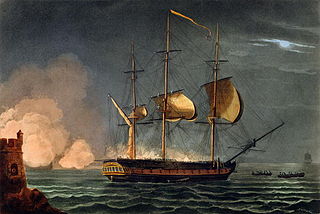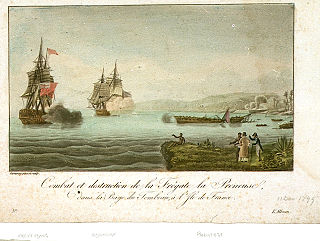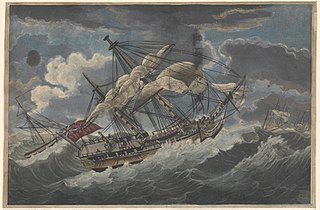
The Spithead and Nore mutinies were two major mutinies by sailors of the Royal Navy in 1797. They were the first in an increasing series of outbreaks of maritime radicalism in the Atlantic World. Despite their temporal proximity, the mutinies differed in character. The Spithead mutiny was a simple, peaceful, successful strike action to address economic grievances, while the Nore mutiny was a more radical action, articulating political ideals as well, which failed.

HMS Neptune was a 98-gun second-rate ship of the line of the Royal Navy. She served on a number of stations during the French Revolutionary and Napoleonic Wars and was present at the Battle of Trafalgar in 1805.

HMS Hermione was the lead ship of the Hermione-class, a six-ship class of 32-gun fifth-rate frigates of the Royal Navy. She was launched on 9 September 1782 at Bristol. Hermione was commissioned and then paid off a number of times during the 1780s. She underwent repairs between October 1790 and June 1792, followed by a period spent refitting at Chatham Dockyard until January 1793. She was recommissioned in December 1792 before sailing to the Jamaica in March 1793. Hermione served in the West Indies during the early years of the French Revolutionary Wars, participating in the British attack on Port-au-Prince, where she led a small squadron that accompanied troop transports.

HMS Thames was a 32-gun Richmond-class fifth-rate frigate of the Royal Navy built by Henry Adams and launched at Bucklers Hard in 1758. She served in several wars, including for some four years in French service after her capture. She was recaptured in 1796 and was broken up in 1803.

HMS Pompee was a 74-gun ship of the line of the British Royal Navy. Built as La Pompée, a Téméraire-class ship of the French Navy, she was handed over to the British at Spithead by French royalists who had fled France after the Siege of Toulon by the French Republic, only a few months after being completed. After reaching Great Britain, La Pompée was registered and recommissioned as HMS Pompee and spent the entirety of her active career with the Royal Navy until she was broken up in 1817.

Sir Charles Cunningham KCH was an officer of the Royal Navy during the late eighteenth and early nineteenth century. He saw action during the American War of Independence and the French Revolutionary and Napoleonic Wars, eventually rising to the rank of rear-admiral.

Admiral The Hon. Charles Elphinstone Fleeming was a Scottish aristocrat and officer of the Royal Navy who served during the French Revolutionary and Napoleonic Wars. He commanded a succession of smaller vessels during the early years of the wars, achieving some successes against French cruisers, merchants and privateers, before losing his ship on one operation. Combining his naval career with periods of political activity he took part in only one major fleet operation, the Battle of Cape Finisterre in 1805, but spent several years as a Member of Parliament. Connected by birth to a major noble landowning family several of his children went on to inherit or marry into titles and rank in the British peerage. Charles himself died an Admiral of the Blue with extensive Scottish estates.
Sir William Hotham GCB was an officer of the Royal Navy who saw service during the French Revolutionary and Napoleonic Wars.

HMS Adamant was a 50-gun Portland-class fourth rate warship of the British Royal Navy. She served during the American War of Independence, the French Revolutionary Wars, and the Napoleonic Wars in a career that spanned thirty years.
James Walker CB, CvTE was an officer of the Royal Navy. He served during the American War of Independence, and the French Revolutionary and Napoleonic Wars, rising to the rank of Rear-Admiral.

HMS Circe was a 28-gun Enterprise-class sixth-rate frigate of the Royal Navy. She was launched in 1785 but not completed or commissioned until 1790. She then served in the English Channel on the blockade of French ports before she was wrecked in 1803.

HMS Clyde was a Royal Navy Artois-class frigate built at Chatham Dockyard of fir, and launched in 1796. In 1797, she was one of only two ships whose captains were able to maintain some control over their vessels during the Nore mutiny. In 1805, HMS Clyde was dismantled and rebuilt at Woolwich Dockyard; she was relaunched on 23 February 1806. She was ultimately sold in August 1814.

Ceres was an East Indiaman launched in 1787. She made three trips to China for the British East India Company (EIC). After the outbreak of war with France in 1793, the Admiralty, desirous of quickly building up the Royal Navy, purchased a number of commercial vessels, including nine East Indiamen, to meet the need for small two-decker fourth rates to serve as convoy escorts. The Admiralty purchased Ceres in 1795 and renamed her HMS Grampus. In 1797 the Admiralty converted her to a storeship. That year her crew participated in the Spithead and Nore mutinies. Grampus grounded in January 1799 and was destroyed.
HMS Bravo was a 16-gun Firm-class floating battery of the Royal Navy, launched in 1794. The two-vessel class was intended to operate in shallow waters. Bravo spent her brief, uneventful service life as the flagship for Commodore Philippe d'Auvergne's flotilla at Jersey. After the Peace of Amiens Bravo was paid off in March 1802; she was sold in 1803.

HMS Calypso was a Royal Navy Echo Class ship-sloop. She was built at Deptford between 1781 and 1783, launched on 27 September 1783 and first commissioned on 1 December 1783 for service off Northern Ireland and Scotland. She served in the North Sea, Atlantic, and the West Indies. Calypso was sunk whilst acting as a convoy escort on 30 July 1803 after colliding with a West Indiaman merchant ship during a violent storm.

HMS Hound was a brig-sloop of the Royal Navy. She had a short history. After her launch in 1796 she captured two privateers and destroyed a third before she was lost in 1800.
Richard Hatherill was a British Royal Navy officer who served during the French Revolutionary War. Born in Queenborough, Kent, on 20 September 1769, he is recorded as having first served aboard HMS Dictator from September 1783. He passed his lieutenant's examination in 1790 and joined HMS Repulse in that capacity on 18 October 1794. It was aboard this ship that he became embroiled in the Nore Mutiny in 1797. Hatherill and other loyal members of the crew were able to retake the ship and bring her in under heavy fire from the other mutinied ships. In 1800, the ship he was serving on was wrecked on the French coast and crew captured. Hatherill was later released in an exchange of officers.
HMS Griper was a Courser-class gunvessel launched in 1797 and sold in 1802.
HMS Wolf was a 4-gun gunvessel, originally a Dutch hoy that the British Admiralty purchased in 1794 for service with the Royal Navy. She was broken up in 1803.
HMS Redoubt was the mercantile Rover, which the Royal Navy purchased in March 1793 on the outbreak of war with France. The Navy fitted her as a floating battery. It sold her in 1802.













